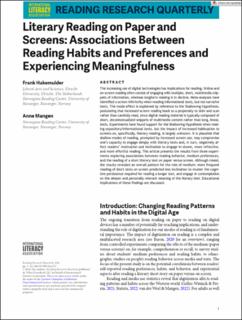| dc.description.abstract | The increasing use of digital technologies has implications for reading. Online and on-screen reading often consist of engaging with multiple, short, multimedia snippets of information, whereas longform reading is in decline. Meta-analyses have identified a screen inferiority when reading informational texts, but not narrative texts. The mode effect is explained by reference to the Shallowing Hypothesis, postulating that increased screen reading leads to a propensity to skim and scan rather than carefully read, since digital reading material is typically composed of short, decontextualized snippets of multimedia content rather than long, linear, texts. Experiments have found support for the Shallowing Hypothesis when reading expository/informational texts, but the impact of increased habituation to screens on, specifically, literary reading, is largely unknown. It is plausible that shallow modes of reading, prompted by increased screen use, may compromise one's capacity to engage deeply with literary texts and, in turn, negatively affect readers’ motivation and inclination to engage in slower, more reflective, and more effortful reading. This article presents the results from three experiments exploring associations between reading behavior, medium preferences, and the reading of a short literary text on paper versus screen. Although mixed, the results revealed an overall pattern for the role of medium: more frequent reading of short texts on screen predicted less inclination to muster the cognitive persistence required for reading a longer text, and engage in contemplation on the deeper and personally relevant meaning of the literary text. Educational implications of these findings are discussed. | en_US |

